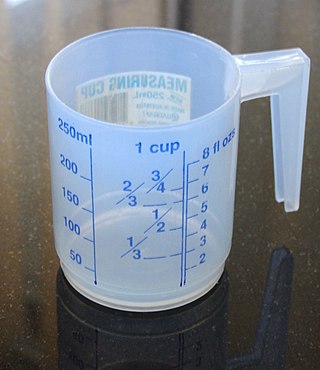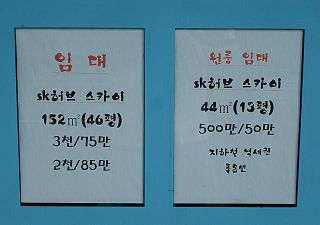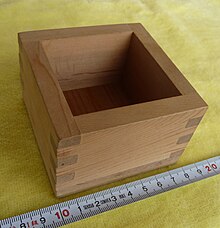
Sake or saké, also referred to as Japanese rice wine, is an alcoholic beverage of Japanese origin made by fermenting rice that has been polished to remove the bran. Despite the name Japanese rice wine, sake, and indeed any East Asian rice wine, is produced by a brewing process more akin to that of beer, where starch is converted into sugars that ferment into alcohol, whereas in wine, alcohol is produced by fermenting sugar that is naturally present in fruit, typically grapes.

A teaspoon (tsp.) is an item of cutlery. It is a small spoon that can be used to stir a cup of tea or coffee, or as a tool for measuring volume. The size of teaspoons ranges from about 2.5 to 7.3 mL. For cooking purposes and dosing of medicine, a teaspoonful is defined as 5 mL, and standard measuring spoons are used.

A tablespoon is a large spoon. In many English-speaking regions, the term now refers to a large spoon used for serving; however, in some regions, it is the largest type of spoon used for eating.
In linguistics, measure words are words that are used in combination with a numeral to indicate an amount of something represented by some noun. Many languages use measure words, and East Asian languages such as Chinese, Japanese, and Korean use them very extensively in the form of number classifiers.

In recipes, quantities of ingredients may be specified by mass, by volume, or by count.

Tael, also known as the tahil and by other names, can refer to any one of several weight measures used in East Asia and Southeast Asia. It usually refers to the Chinese tael, a part of the Chinese system of weights and currency. The Chinese tael was standardized to 50 grams in 1959.

Chinese units of measurement, known in Chinese as the shìzhì, are the traditional units of measurement of the Han Chinese. Although Chinese numerals have been decimal (base-10) since the Shang, several Chinese measures use hexadecimal (base-16). Local applications have varied, but the Chinese dynasties usually proclaimed standard measurements and recorded their predecessor's systems in their histories.
The koku (石) is a Chinese-based Japanese unit of volume. 1 koku is equivalent to 10 to or approximately 180 litres, or about 150 kilograms (330 lb) of rice. It converts, in turn, to 100 shō and 1000 gō. One gō is the volume of the "rice cup", the plastic measuring cup that is supplied with commercial Japanese rice cookers.

Gochujang or red chili paste is a savory, sweet, and spicy fermented condiment popular in Korean cooking. It is made from gochu-garu, glutinous rice, meju powder, yeotgireum, and salt. The sweetness comes from the starch of cooked glutinous rice, cultured with saccharifying enzymes during the fermentation process. Traditionally, it would be naturally fermented over years in jangdok (earthenware) on an elevated stone platform called jangdokdae in the backyard.

Makgeolli, sometimes anglicized to makkoli, is a Korean alcoholic drink. It is a milky, off-white, and lightly sparkling rice wine that has a slight viscosity, and tastes slightly sweet, tangy, bitter, and astringent. Chalky sediment gives it a cloudy appearance. As a low proof drink of six to nine percent alcohol by volume, it is often considered a "communal beverage" rather than hard liquor.

Li, also known as the Chinese mile, is a traditional Chinese unit of distance. The li has varied considerably over time but was usually about one third of an English mile and now has a standardized length of a half-kilometer. This is then divided into 1,500 chi or "Chinese feet".

A solar term is any of twenty-four periods in traditional Chinese lunisolar calendars that matches a particular astronomical event or signifies some natural phenomenon. The points are spaced 15° apart along the ecliptic and are used by lunisolar calendars to stay synchronized with the seasons, which is crucial for agrarian societies. The solar terms are also used to calculate intercalary months; which month is repeated depends on the position of the sun at the time.
The catty, kati or 斤, pronounced as jīn in Mandarin and gan in Cantonese, is a traditional Chinese unit of mass used across East and Southeast Asia, notably for weighing food and other groceries. Related units include the picul, equal to 100 catties, and the tael, which is 1⁄16 of a catty. A stone is a former unit used in Hong Kong equal to 120 catties and a gwan (鈞) is 30 catties. Catty or kati is still used in Southeast Asia as a unit of measurement in some contexts especially by the significant Overseas Chinese populations across the region, particularly in Malaysia and Singapore.

The cup is a cooking measure of volume, commonly associated with cooking and serving sizes. In the US, it is traditionally equal to one-half US pint (236.6 ml). Because actual drinking cups may differ greatly from the size of this unit, standard measuring cups may be used, with a metric cup being 250 millilitres.
Traditional Japanese units of measurement or the shakkanhō (尺貫法) is the traditional system of measurement used by the people of the Japanese archipelago. It is largely based on the Chinese system, which spread to Japan and the rest of the Sinosphere in antiquity. It has remained mostly unaltered since the adoption of the measures of the Tang dynasty in 701. Following the 1868 Meiji Restoration, Imperial Japan adopted the metric system and defined the traditional units in metric terms on the basis of a prototype metre and kilogram. The present values of most Korean and Taiwanese units of measurement derive from these values as well.

A pyeong is a Korean unit of area and floorspace, equal to a square kan or 36 square Korean feet. The ping and tsubo are its equivalent Taiwanese and Japanese units, similarly based on a square bu or ken, equivalent to 36 square Chinese or Japanese feet.
A mace is a traditional Chinese measurement of weight in East Asia that was also used as a currency denomination. It is equal to 10 candareens and is 1⁄10 of a tael or approximately 3.78 grams. A troy mace is approximately 3.7429 grams. In Hong Kong, one mace is 3.779936375 grams. and in Ordinance 22 of 1884, it is 2⁄15 ounces avoirdupois. In Singapore, one mace is 3.77994 grams.
Vietnamese units of measurement are the largely decimal units of measurement traditionally used in Vietnam until metrication. The base unit of length is the thước or xích. Some of the traditional unit names have been repurposed for metric units, such as thước for the metre, while other traditional names remain in translations of imperial units, such as dặm Anh for the mile.
Approximate measures are units of volumetric measurement which are not defined by a government or government-sanctioned organization, or which were previously defined and are now repealed, yet which remain in use.
Korean units of measurement, called cheokgwan-beop or cheokgeun-beop in Korean, is the traditional system of measurement used by the people of the Korean peninsula. It is largely based on the Chinese system, with influence from Japanese standards imposed following its annexation of the Korean Empire in 1910. Both North and South Korea currently employ the metric system. Since 2007, South Korea has criminalized the use of Korean units in commercial contexts, but informal use continues, especially of the pyeong as a measure of residential and commercial floorspace. North Korea continues to use the traditional units, although their standards are now derived from metric conversions.











